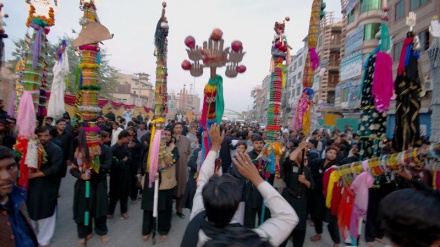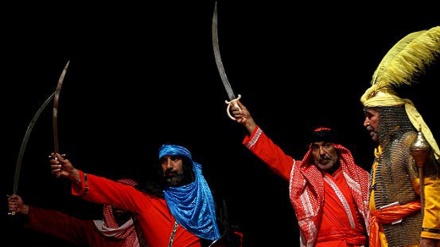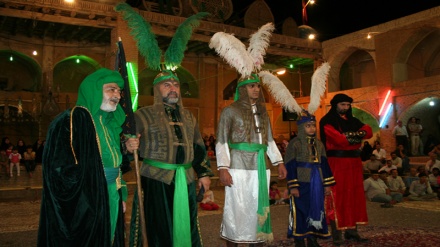Muharram mourning traditions in different lands - 34
Welcome to the 34th part of the series titled “Muharram Mourning Traditions in Different Lands” that we started broadcasting as of October 15 on a daily basis, to commemorate the heartrending tragedy of Karbala, and the martyrdom of Imam Husain (AS), the grandson of Prophet Mohammad (SAWA).
In this series, which delves into the mourning traditions associated with the Immortal Epic of Ashura, we have been focusing on the various norms prevalent in different towns and cities of Iran for commemorating the heartrending tragedy of Karbala, after having dwelt on the history of mourning in different countries of the world for Imam Husain (AS).
Today we talk about “Shaam-e- Gharibaan” which is Persian for the tragic evening that befell the bereaved ladies and orphaned children of the household of the Prophet’s family on Ashura of 10th Muharram, following heartrending martyrdom from morning till afternoon, of the Imam, his sons, brothers, nephews, and companions. Shaam is Persian for evening, while Gharibaan means travelers, and it refers to the fact that the Prophet’s Ahl al-Bayt were in a foreign land as travelers far away from their hometown Medina, when the bloodcurdling tragedy of Karbala and its equally heart-wrenching aftermath, befell them. On that evening, the brutal Omayyad soldiers burnt down the tents or encampment of the Imam, thereby increasing the grief and plight of the horrified survivors. Thus, “Shaam-e- Gharibaan” is a reminder of the deep sadness, enormous loss, and profound grief of the members of the Imam’s family following his martyrdom. Stay with us.
The mourning ceremony on the “tragic evening of 10th Muharram” is often simple and without the flags, standards, and banners which were so prominent in the previous nights and throughout the fateful day of Ashura. Groups of mourners, all clad in black, light up candles in streets and alleys, and as they walk, they beat their heads, as a sign of grief for the helpless and horrified survivors, while chanting elegies and lamentations. The elegies are a reminder of the tragedy and calamity which befell the wailing women and shrieking children of the Ahl al-Bayt (Peace be upon them) after the events in Karbala.
There is little difference in the way the “Shaam-e- Gharibaan” mourning ceremony is performed in various regions of Iran. What differences there are, are only minor in nature. On the evening that follows the fateful day of Ashura, virtually every mosque and husseiniyeh throughout the Islamic Republic of Iran is crowded with mourners grieving the martyrdom of Imam Husain (AS). It is also true to say that in the shrine cities of Iran, such as Qom and Mashhad, the “Shaam-e- Gharibaan” mourning ceremony is more elaborate and extensive, compared to other cities, as thousands of pilgrims from all over Iran and from various parts of the world, join the commemoration ceremonies.
The city of Qom, which is indeed the religious capital of Iran and the world-famous centre for dissemination of the pure and pristine teachings of Islam, as taught by the Prophet and his Immaculate Ahl al-Bayt, is completely in mourning and dressed in black every Muharram. The mourning tradition of “Shaam-e- Gharibaan” is prominently observed in the city of Qom. During Muharram, and particularly on the 9th and 10th of the month, mourning processions from all districts of Qom converge on the centre of the city, which has in its midst the holy golden-domed shrine of Hazrat Fatemah al-Ma’soumah (SA), the sister of the Prophet’s 8th Infallible heir, Imam Reza (AS), who reposes in peace in Mashhad. In this year’s “Shaam-e- Gharibaan” ceremony, a symbolic “Caravan of the Captives”, featuring grief-stricken children and ladies, made its way mournfully and tearfully towards the shrine of Ma’soumah. The “Caravan of the Captives” is a reminder of what happened to family of Imam Husain (AS), and the sufferings they endured, particularly the sufferings of the Imam’s sister, Hazrat Zainab (SA) and the Imam’s surviving son and successor, Imam Zain al-Abedin (AS).
Special “Shaam-e- Gharibaan” mourning ceremony is held every Muharram, at the Holy Shrine our Revered Immaculate Lady of Qom, Hazrat Ma’soumah (SA). Needless to say that huge mourning processions commemorate the Day of Ashura and the “tragic evening” of “Shaam-e- Gharibaan” in Qom every year.
MD/AS/ME


